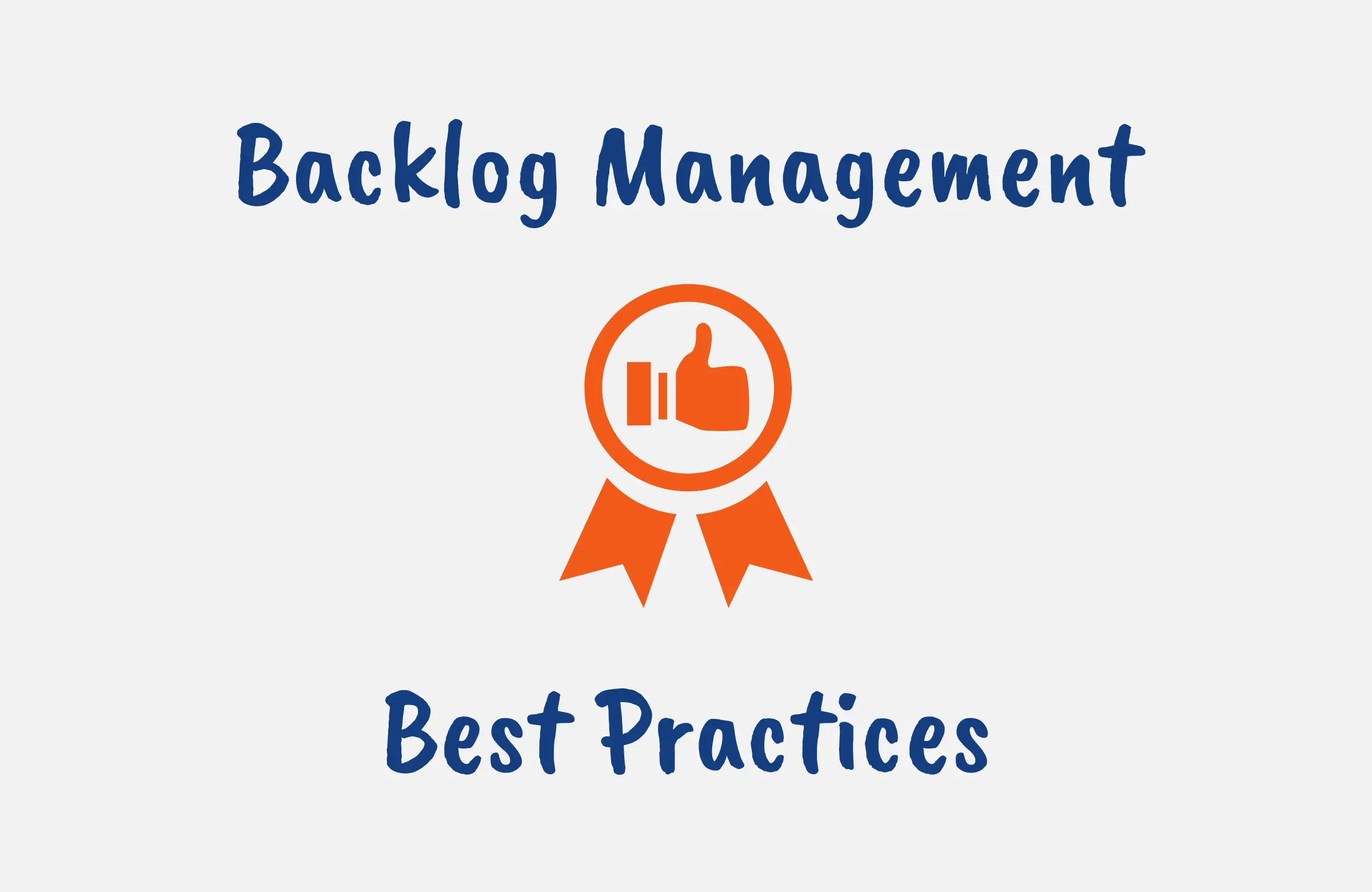The Product Backlog is the single source of requirements for a product being developed in Agile Scrum development.
It contains the description of all possible features, functions, requirements, enhancements, and fixes that constitute the changes to be made to the product in future releases.
Managing the backlog to ensure that it is constantly updated and aligned with the vision of the product is critical to value delivery.
However, this can be challenging as Agile is a change-driven methodology where business and stakeholder requirements are apt to change frequently.
In this post, we will cover what Product Backlog management is all about, its importance and challenges, as well as Product Backlog best practices.
What is Product Backlog Management?
Product Backlog management refers to the continuous grooming and prioritization of the backlog by adding details to items, breaking them into smaller pieces of work, estimating effort with story points, and most importantly prioritizing the Product Backlog items (PBIs) based on business value.
The highest priority features and user stories are kept at the top of the backlog so they can be pulled into upcoming Sprints by the team.
The Product Owner works closely with stakeholders and the team to constantly update and refine the backlog as a roadmap for product development.

Product Backlog Management Best Practices
Managing the Product Backlog well is crucial for the success of Agile Scrum. Here are 10 Product Backlog management best practices you can leverage:
1. Regularly Groom Your Product Backlog
To ensure that your backlog is constantly actionable and manageable, regular grooming sessions should be scheduled to continuously prioritize, refine, and clean up the Product Backlog.
Add details like acceptance criteria, mockups, and estimates to high-priority items, and remove items that have lost priority or are no longer relevant.
2. Keep Items Small and Testable
If a user story is too large (often called an epic), it should be broken down into smaller, manageable pieces.
These smaller stories should still deliver value to the user, and not be so dependent on each other that they can’t be worked on independently.
3. Write Clear and Concise User Stories
Each item in the backlog should be written as a user story, which is a short, simple description of a feature told from the perspective of the person who desires the new capability.
The format should be: “As a [type of user], I want [an action] so that [a benefit/a value]”.
Stories should follow the 3 Cs of user stories and the INVEST framework (Independent, Negotiable, Valuable, Estimable, Small, and Testable).
4. Prioritize Ruthlessly
The Product Backlog should always be organized by priority. Ensure that the most important items that deliver the most value to the user, should be at the top.
This prioritization should be a continuous process, and changes based on business needs, user feedback, and market research.
5. Include Non-Functional Items
In addition to features, your Product Backlog should include non-functional items like bugs, technical debt, infrastructure improvements, defects, and security updates.
These items ensure a high-quality product and smooth development.
6. Define Clear Acceptance Criteria
For each user story, include a clear and agreed-upon “Definition of Done“. This is a list of criteria that must be met before a Product Increment is considered “done”.
7. Provide Effort Estimates
Each item in the backlog should have an estimate of the effort required to complete it. This can be done using story points, ideal days, or any other unit of measure that the team prefers.
This way, during Sprint Planning, the development team can select the right amount of work for the upcoming sprint that matches their capacity.
8. Avoid Overloading the Backlog
The backlog should not be overloaded with too many items as a crowded backlog can become a source of confusion and can dilute focus.
It should be a living document, with items added, changed, and removed continuously.
9. Use Collaboration
Backlog management should be a collaborative effort. It’s not just the Product Owner’s responsibility. Developers, stakeholders, and especially users should have input into the backlog.
10. Focus on Continuous Learning
Use retrospectives and other feedback mechanisms to continuously improve your backlog management process.
Experiment with different techniques, learn from your experiences and adapt your approach as needed.

Importance of Product Backlog Management
An ineffective Product Backlog sets up the team for failure, while a well-managed backlog empowers the team to deliver maximum value.
Here’s why backlog management is so important:
1. Provides a Prioritized Roadmap
A well-prioritized backlog gives the team clarity on what the most important items are to work on next. Without proper priorities, the team lacks direction.
This roadmap ensures the team delivers maximum business value by working on the highest return features first.
2. Focuses the Team
Continuously grooming the backlog by removing low-priority items declutters it and helps the team stay focused as a bloated backlog is overwhelming.
By limiting work-in-progress, the team can concentrate on the most critical few items.
3. Sets Clear Expectations
Adding details like acceptance criteria, mockups, and task checklists to backlog items sets clear expectations for work completion.
This level of transparency improves quality and productivity.
4. Enables Execution
Well-written user stories empower the team to quickly start working within a sprint as vague, complex backlog items cause delays.
With clear, INVEST-compliant user stories, the team can jump right into development and testing.
5. Facilitates Sprint Planning
Backlog items sized with story points make Sprint Planning easier.
The team can pull in the right amount of work based on estimated effort and their capacity ensuring there are no unwanted surprises or unfinished work at the end of the Sprint.
6. Allows Flexibility
Proper backlog management isn’t a one-time activity. As priorities change, continuous grooming means you can re-order and refine the backlog to give the team the most important work.

Product Backlog Management Activities
Proper backlog management takes some work but pays huge dividends through empowered teams and the efficient delivery of value.
As a Product Owner, you’ll engage in various activities regularly to groom and manage the product backlog well.
1. Creation of Product Backlog Items (PBIs)
Your journey begins with identifying and creating Product Backlog Items (PBIs). Each PBI should be a feature, enhancement, or requirement that adds value to the product.
It’s important to describe these items clearly and concisely.
2. Prioritization of PBIs
Next, you need to prioritize the items in your backlog. The items that deliver the most value to the user or the business should be at the top.
Prioritization should be a continuous process as business needs, customer preferences, and market trends evolve.
3. Estimation of Effort
For each backlog item, you should estimate the effort required to complete it. This can be done using story points, hours, or any other measure your team prefers.
Accurate estimation helps in Sprint Planning and resource allocation.
4. Backlog Refinement (Grooming)
This is the process of reviewing and adjusting the backlog periodically. Backlog grooming ensures that the backlog remains relevant, properly prioritized, and ready for future Sprints.
During this process, you might break down large items, revise priorities, or remove items that are no longer needed.
5. Review and Adjustment
Regularly review the Product Backlog with your team and stakeholders. This is the time to gather feedback and make necessary adjustments.
Reviewing the backlog regularly ensures that it aligns with the changing needs of customers and business objectives.
6. Setting Definition of Done (DoD)
Establish a shared understanding of what it means for a PBI to be ‘done’. A clear DoD ensures consistency and quality in the work delivered.
This usually includes development, testing, documentation, and other necessary activities.

Effective Product Backlog Management Tools and Techniques
For effective Product Backlog management, there are several tools and techniques that you can leverage based on your team’s needs, your product, and your working environment.
Here are some to keep in mind:
1. User Stories
Writing Product Backlog items (PBIs) as user stories is a powerful technique. A user story is a simple description of a feature from the perspective of the user.
It focuses on the value that the feature provides to the user, helping to ensure that the product meets user needs and expectations.
2. Prioritization Techniques
There are several techniques that you can use to prioritize PBIs, such as the MoSCoW method, the Value vs Effort matrix, or the RICE score model.
These techniques help to ensure that you’re always working on the most valuable features.
3. Estimation Techniques
Techniques like Planning Poker, T-Shirt Sizing, and the Fibonacci sequence can be used to estimate the effort required for each PBI.
These techniques involve the entire team, helping to ensure that estimates are realistic and consensus-based.
4. Backlog Grooming
As earlier iterated, regular backlog grooming sessions are essential to keep your backlog up-to-date and ready for development.
This includes re-prioritizing items, breaking down large items, adding new items, and removing unnecessary ones.
5. Feedback Loops
Regular reviews and retrospectives provide valuable feedback that can be used to adjust the backlog and improve your backlog management process.
They help to ensure that your product continues to meet user needs and business objectives.
6. Visualization Tools
Tools like Kanban boards, burn-down charts, and project management software can be used to visualize your backlog and progress.
They provide a clear view of your current work, completed work, and upcoming work, helping to manage expectations and keep everyone on the same page.

Product Backlog Management Challenges
Product Backlog management has its unique challenges. These include:
1. Prioritization
Striking the right balance in prioritizing features can be difficult as you need to consider different variables including business value, user needs, technical feasibility, and more.
The challenge lies in aligning these diverse needs and focusing on what brings the most value.
2. Overloaded Backlog
When developing products, it’s easy for the backlog to become a dumping ground for every idea, resulting in a bloated and unmanageable list.
This can make it difficult to identify what to work on next leading to decreased team efficiency.
3. Unclear User Stories
If user stories are not well-defined or clear, it can lead to confusion, incorrect assumptions, and ultimately, a product that doesn’t meet user needs or expectations.
4. Inaccurate Estimation
Estimating the effort for a task is not an easy job. Over-estimation can lead to idle time and inefficiencies, while under-estimation can lead to overworked team members and missed deadlines.
5. Lack of Stakeholder Engagement
Effective backlog management requires active engagement from all your stakeholders.
If the team, management, or customers are not actively involved, the backlog may not accurately reflect the necessary work or the priorities may not align with actual needs.
6. Resistance to Change
Agile is about embracing change, but change can be difficult. There can be a reluctance to re-prioritize or adjust the backlog based on new information, which can lead to lost opportunities or wasted effort.
How the Scrum Master Helps the Product Owner in Product Backlog Management
While the Product Backlog is owned by the Product Owner, its management remains a collaborative endeavor encompassing the team and relevant stakeholders.
If you are a Scrum Master, a part of your role is to facilitate effective Product Backlog Management and provide the necessary support to the Product Owner to ensure a successful product.
Here’s how you can contribute:
1. Facilitation
One of your primary roles is to facilitate backlog refinement sessions. You can ensure that these sessions are effective and productive, with clear goals and outcomes.
2. Coaching
You can help the Product Owner understand and apply effective backlog management techniques. This can include writing good user stories, prioritizing items, or estimating effort.
3. Communication
As a Scrum Master, you act as a bridge between the development team and the Product Owner.
You can facilitate communication, ensuring that everyone understands the backlog items and their priorities.
4. Removal of Impediments
If there are any obstacles hindering the backlog management process, it’s your responsibility to address and remove them.
This could be anything from clarifying doubts about user stories to resolving conflicts within the team.
5. Promoting Agile Values
You can help the Product Owner and the team to embrace the values of Agile and Scrum. This includes openness to change, focus on delivering value, and continuous improvement.
Conclusion
The Product Backlog is the central source of truth for the development team. Keeping it healthy through continuous prioritization, grooming, and refinement activities enables the team to deliver maximum value efficiently.
By leveraging these best practices, managing your Product Backlog would be a whole lot easier and enable you to surmount most of the common challenges.
Product Backlog Management FAQs
What does Product Backlog Management Include?
Product Backlog Management includes creating and prioritizing Product Backlog Items (PBIs), estimating effort, refining the backlog, and regularly reviewing and adjusting it.
It also entails setting a clear Definition of Done (DoD) and fostering a shared understanding among the team and stakeholders.
Who Owns Product Backlog Management?
The Product Owner owns Product Backlog Management in an Agile team. They are responsible for creating, prioritizing, refining, and adjusting the product backlog, ensuring it aligns with user needs and business goals.
However, it’s a collaborative process involving the whole team.





